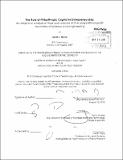The role of philanthropic capital in entrepreneurship : an empirical analysis of financial vehicles at the nonprofit/for-profit boundary of science and engineering
Author(s)
Wood, Sarah J
DownloadFull printable version (7.991Mb)
Alternative title
Empirical analysis of financial vehicles at the nonprofit/for-profit boundary of science and engineering
Other Contributors
Massachusetts Institute of Technology. Technology and Policy Program.
Advisor
Fiona Murray.
Terms of use
Metadata
Show full item recordAbstract
Not-for-profit funding from wealthy individuals and their foundations is widely used to support science and engineering research within the university, but is not currently being used to fund the translation of those ideas towards greater impact. Entrepreneurship is a powerful engine for moving from idea to impact, but for-profit investments in early-stage companies fail to account for investors' charitable objectives and are not rewarded for social returns. Conversely, tax-shielded "charitable" funds are rarely used in for-profit technology companies regardless of their desirable social outcomes. As a result, there is often a limited amount of capital available to companies in areas such as energy, water and human disease because neither pure philanthropic nor pure profit motives sufficiently justify investment. Traditional explanations for funding gaps fail to recognize that the shortfall due to both the risk profile of potential investments, and the poor match between the social and private interests of "investors" and the types of vehicles that might allow a mix of philanthropic and financial motives to sit side-by-side. To address this challenge, we asked a simple question: What financial approaches and organizational structures can be deployed at the intersection of the non-profit and for-profit boundary to address the funding gaps in science and engineering commercialization? To explore this issue, we conducted interviews, reviewed legal texts and relevant literature, and compiled data from online sources. Our findings reveal a sophisticated set of tools that are historically under-used, but which have the potential to advance many areas of science and engineering that hold solutions to global issues, such as health, environment, water, and energy.
Description
Thesis (S.M. in Technology and Policy)-- Massachusetts Institute of Technology, Engineering Systems Division, Technology and Policy Program, 2012. Cataloged from PDF version of thesis. Includes bibliographical references (p. 66-70).
Date issued
2012Department
Massachusetts Institute of Technology. Engineering Systems Division; Technology and Policy ProgramPublisher
Massachusetts Institute of Technology
Keywords
Engineering Systems Division., Technology and Policy Program.